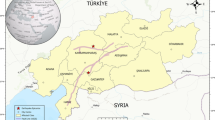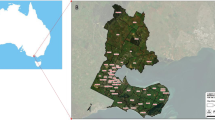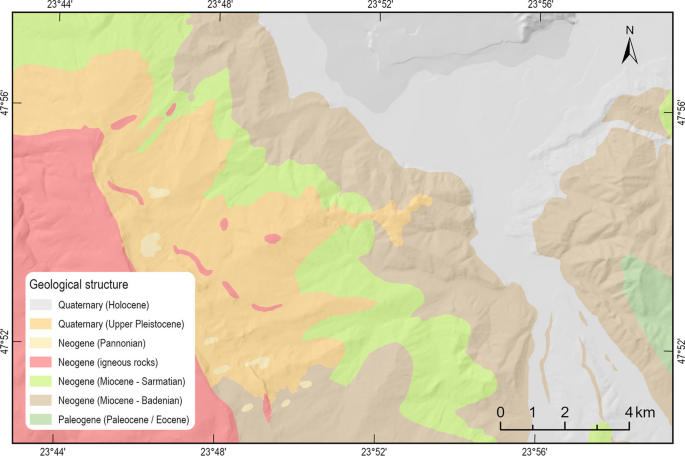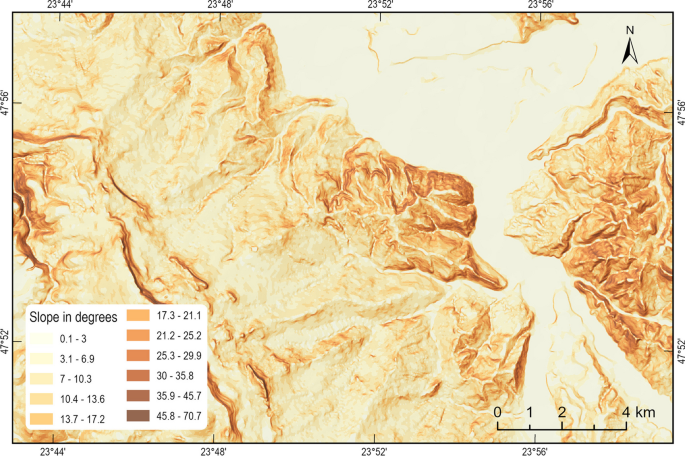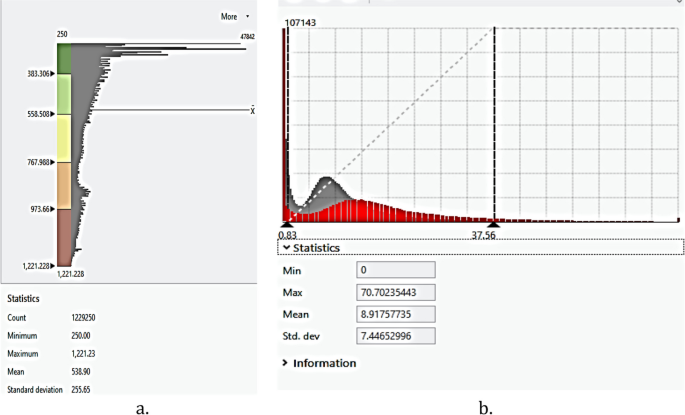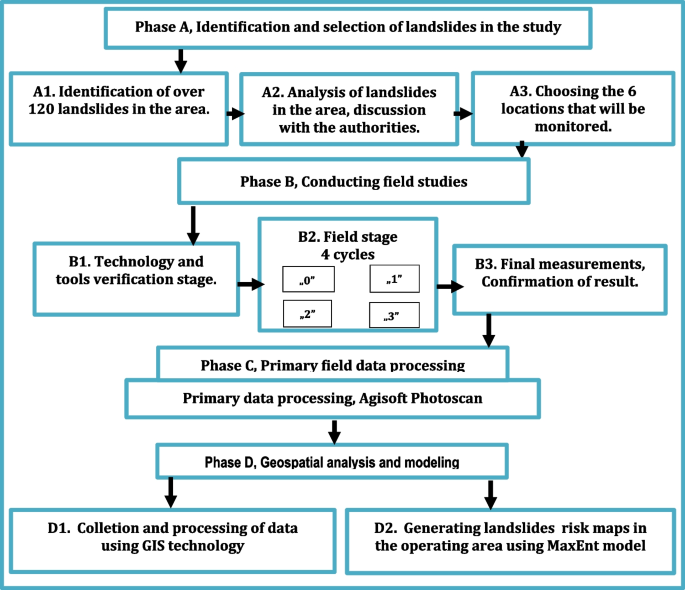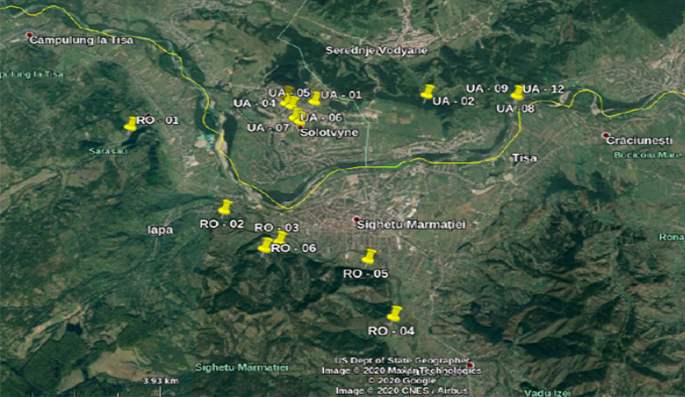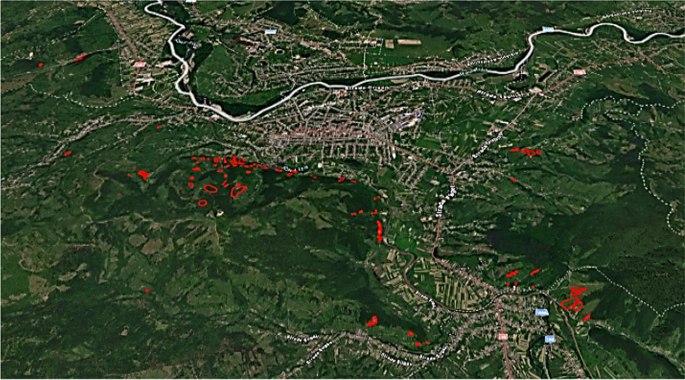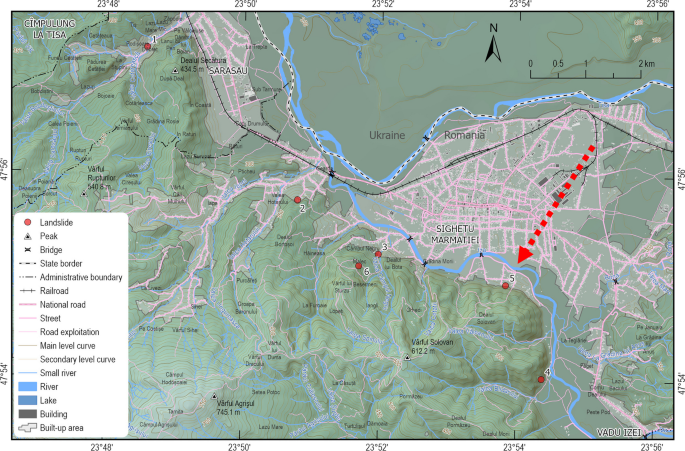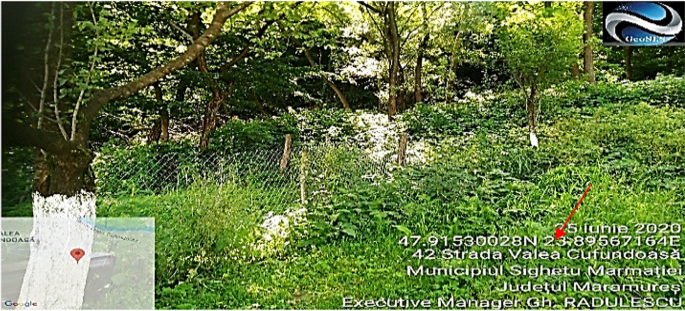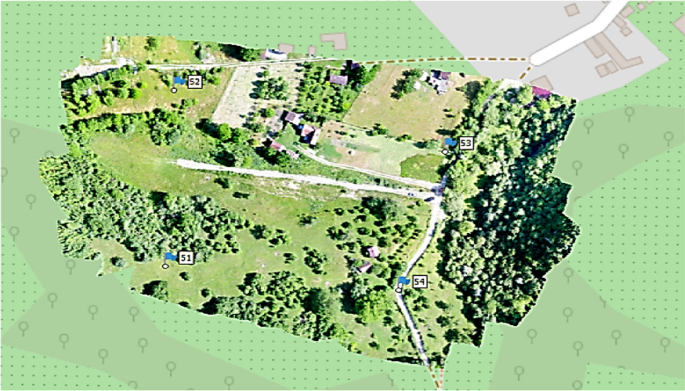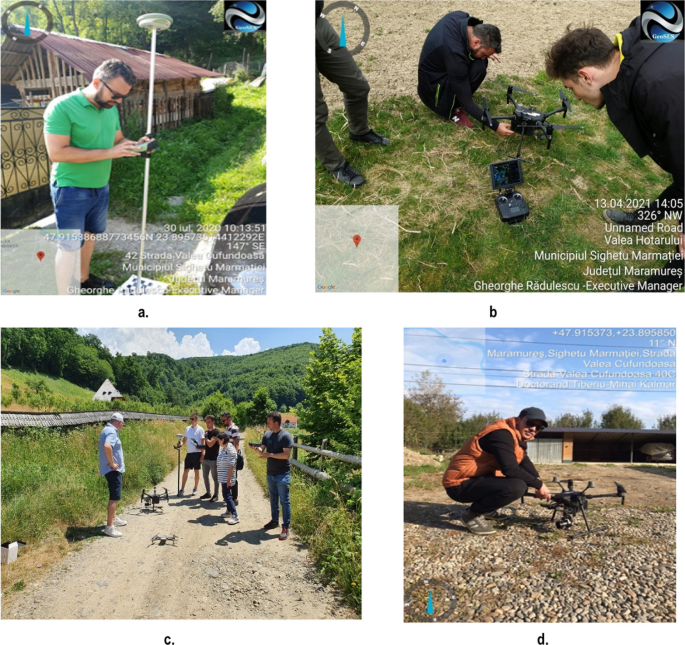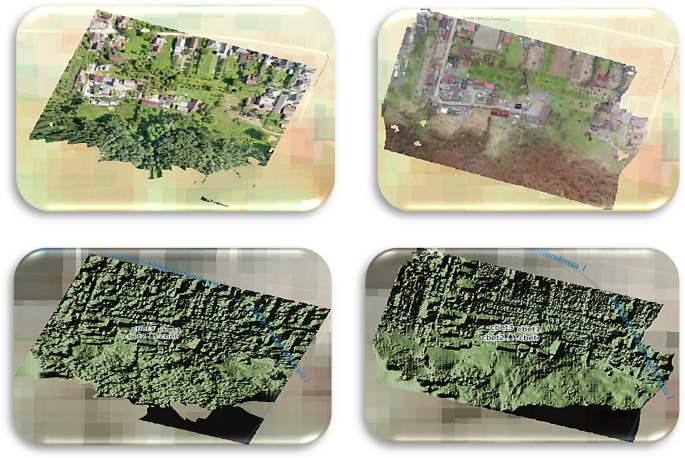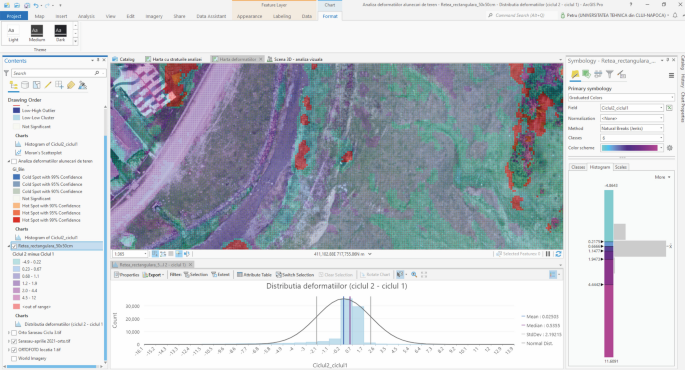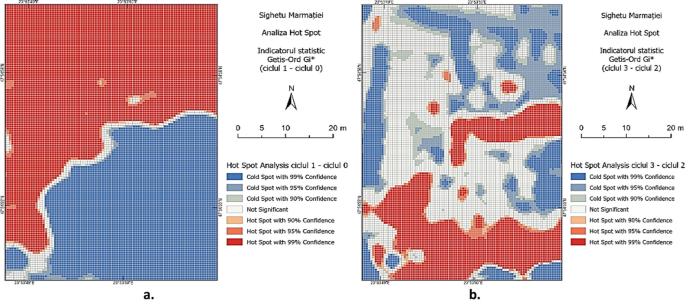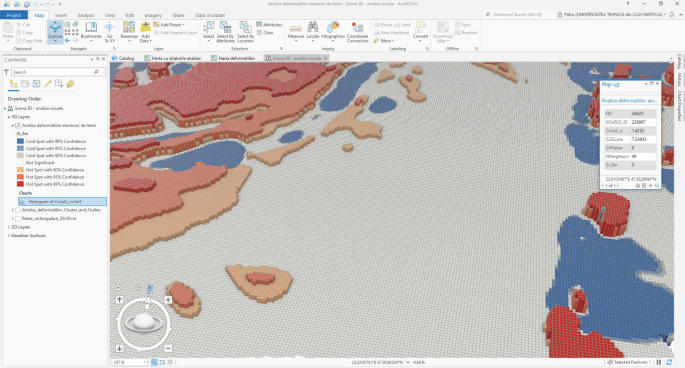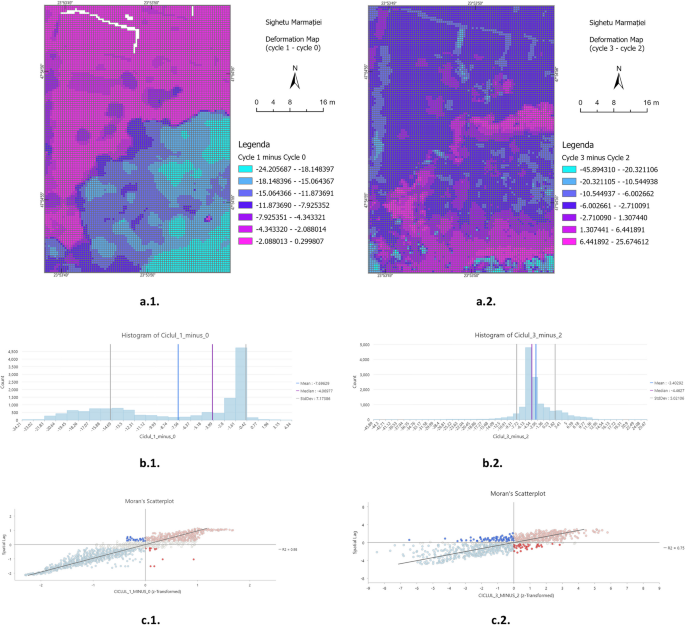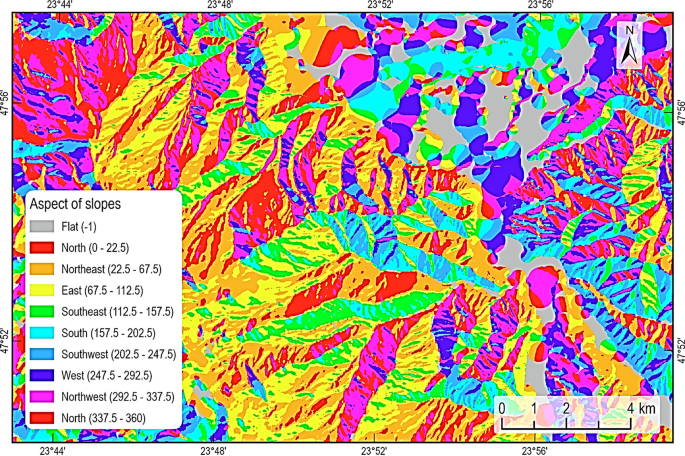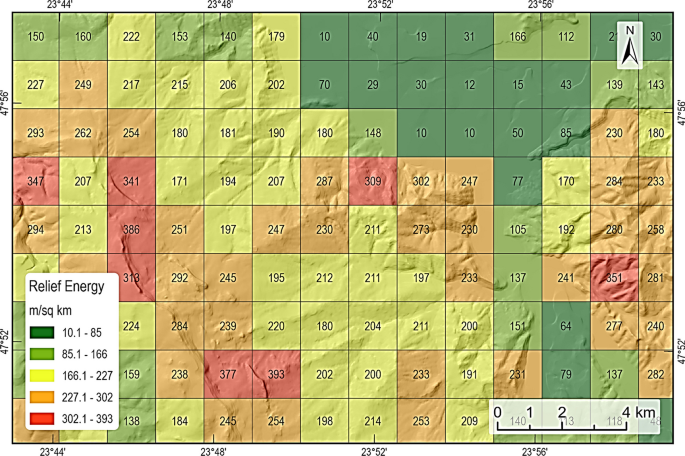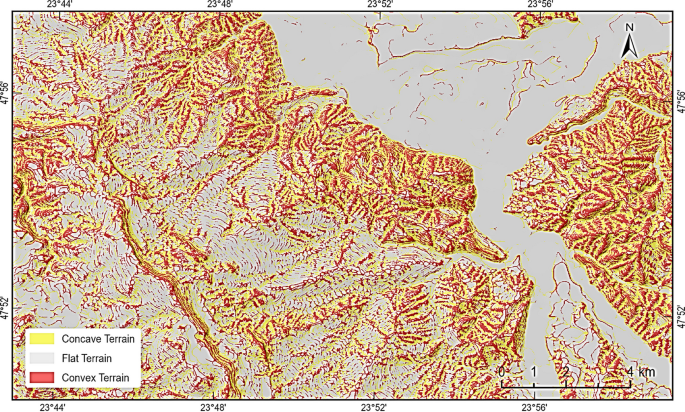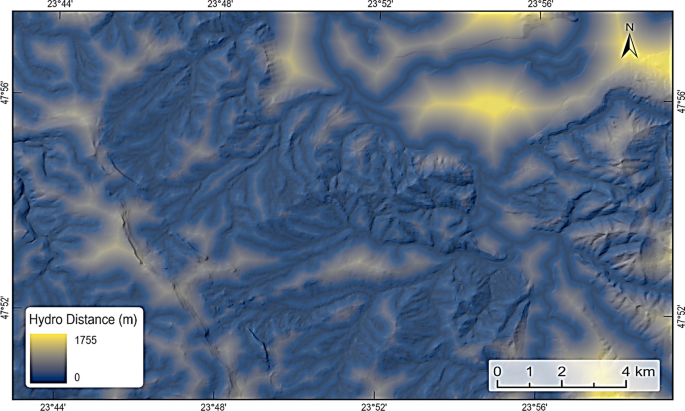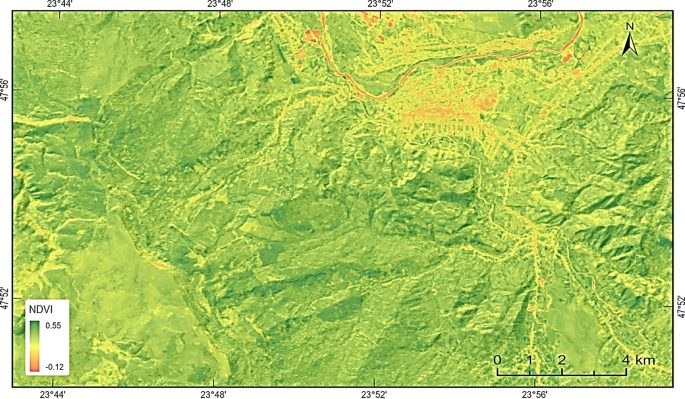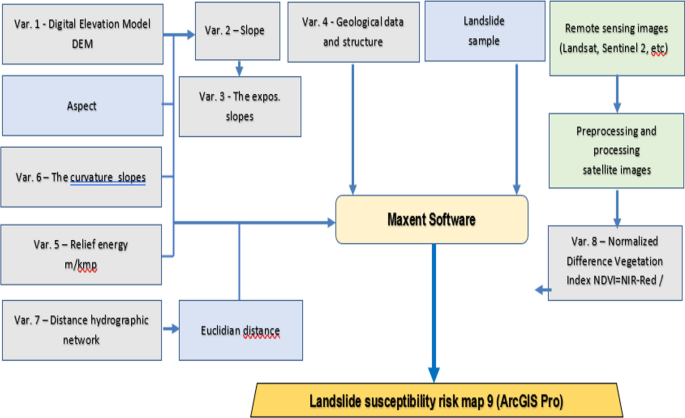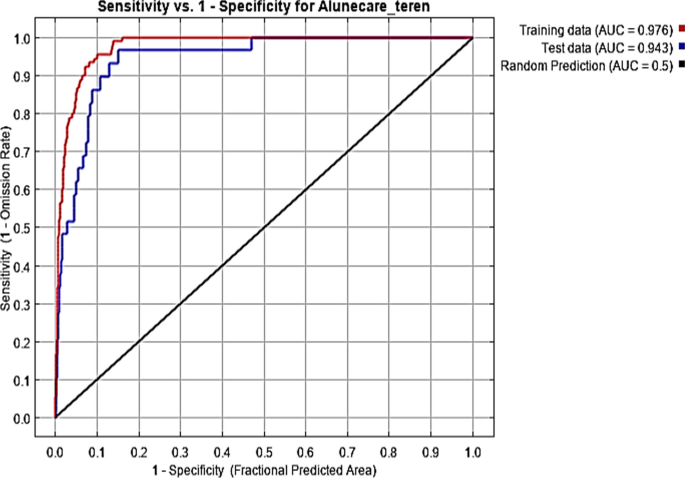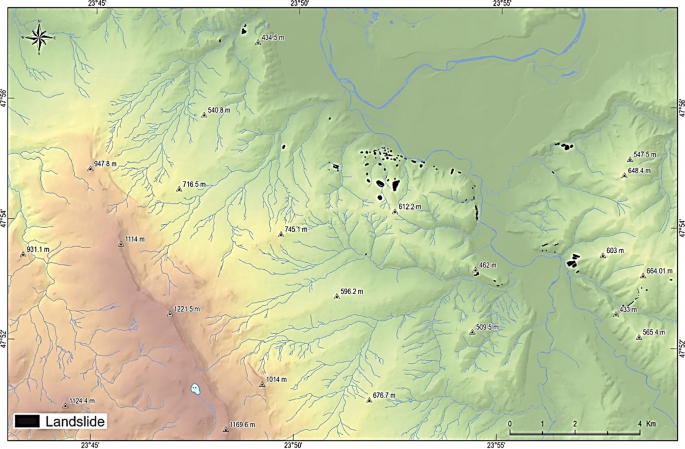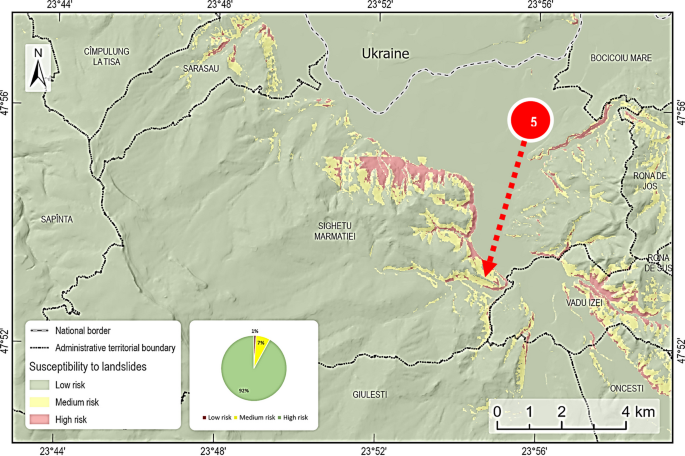Abstract
Landslides are a significant geological phenomenon with the potential for catastrophic consequences. There are numerous potential causes of landslides, including both natural and man-made ones. Their growing frequency raises alarm due to the often catastrophic consequences of these events. The monitoring of regions prone to landslides is a multifaceted undertaking that involves the use of several technologies and approaches, such as geospatial technology and modeling. The primary objective of this work is to construct a spatial analysis model for a region in north-western Romania that is susceptible to landslides. A case study was conducted to estimate the susceptibility of landslides in a monitored region located near Sighetu Marmației, Romania. To achieve this objective, a combination of several technologies and approaches were used, such as remote sensing, land surveying, aerial photogrammetry, geographic information systems, and spatial modeling. The research region underwent landslide susceptibility evaluation by processing geo-information data using Geographic Information Systems (GIS) and developing a prediction model based on the MaxEnt (Maximum Entropy) approach. The research’s distinctive contribution is integrating geo-information data acquired from the hazardous site utilizing geomatics methods into a novel geo-monitoring system. The research offers valuable insights into the monitoring of landslides, adding to the current body of literature by introducing an expanded paradigm. The study’s theoretical and practical implications might be valuable for professionals, local authorities, emergency response agencies, and other parties involved in mitigating the danger of landslides.
Similar content being viewed by others
Avoid common mistakes on your manuscript.
Introduction
Landslides are the most common natural catastrophes worldwide, resulting in human fatalities, damage of structures, and significant economic disruptions (Dai et al. 2002a). Landslides are geological events that may occur naturally or as a result of human activities. They include the downward displacement of material caused by instability (Dai et al. 2002a; Larsen 2008).
Most types of mass movements usually involve shallow debris that can fall quickly or slowly. If the movement is fast, it can cause serious damage, but if the movement is slow, it is possible to take steps to prevent the damage (Dai et al. 2002a). Landslides can be triggered by prolonged and intensified rains, earthquakes or volcanoes (Larsen 2008). Other landslides are also aided by rock degradation and soil erosion, thus having a direct impact on slope stability (Gonzalez Ollauri and Mickovski 2017). The susceptibility of a given area to landslides can be determined and described based on hazard zoning (Rossi et al. 2010).
Reported landslides are usually understated, for various reasons (Kirschbaum et al. 2015; Froude and Petley 2018) and thus total rates are likely underreported. Infrastructure is also frequently affected, with damages exceeding a billion annually in the US alone (Dale et al. 2001).
The frequent occurrence of disaster phenomena is increasingly associated with the effects of climate change. Climate change is predicted to increase the rate of landslides due to more frequent and stronger storms (Dale et al. 2001), which historically correlate with increased landslides (Kirschbaum and Stanley 2018). However, the long-term implications of respective landslides, mass removal and translocation of soil, initiation of succession in the first place (Walker and Shiels 2012) and implications of potential future developments due to increased storm intensity/precipitation (Jakob and Lambert 2009) require a strong understanding of how these ecosystems respond and recover from landslides.
Numerous studies address the assessment of hazards and the monitoring of these risks (Alimohammadlou et al. 2013; Dai et al. 2002b; Sim et al. 2022; Alcántara-Ayala and Sassa 2023). Still unsolved, nevertheless, is the complex problem of studying an effective monitoring system that combines a variety of approaches and technologies. As the number of disasters in the surrounding regions rises, it is necessary to step up research and promote cooperation with specialists in the impacted countries.
This study aims to provide a comprehensive system for monitoring landslides occurring on the north-western border of Romania. The system utilizes geomatics technology and does geospatial analysis to construct a prediction model using the MaxEnt approach (https://pro.arcgis.com/en/pro-app/latest/tool-reference/spatial-statistics/how-presence-only-prediction-works.htm).
To conduct the empirical study, a project was chosen aimed at geo-monitoring landslides in the cross-border region of Romania, focusing on the area of Sighetu Marmației municipality.
The paper first emphasizes the monitoring steps used in the project to underscore the intricacy of the research activities that resulted in the development of a comprehensive system for monitoring landslides in the cross-border region. Next, the research proceeds by doing a geospatial analysis. This involves selecting a specific location within the project for the empirical investigation and constructing a geospatial model using the MaxEnt approach.
The paper is divided into four sections (Kalmar 2023): “Introduction” section which comprises a part dedicated to theoretical frame of landslides monitoring. Next, the section dedicated to “Materials and methods”, by emphasizing the monitoring stages that led to the development of a comprehensive system for monitoring landslides in the cross-border region. The investigation then proceeds with a geospatial analysis and modeling exhibited in “Conclusion” section. The results, indicate that integrating geomatics technology and geospatial analysis techniques is the most effective strategy for enhancing landslide monitoring efficacy.
Landslide susceptibility and monitoring methods and technologies
Determining factors of landslides
The natural causes of landslides are investigated based on the scale at which they occur in a given location (Abedin et al. 2020). The factors that are examined at the local level include terrain conditions and physical processes. On the other hand, the analysis at the regional level encompasses geological, geomorphological, climatic, and hydrological factors, as well as land cover. These factors contribute to the identification of derived sub-factors such as slope, terrain profile and curvature, geological composition, humidity, and depth of fragmentation. The lithology of the land and the plant cover are significant factors that contribute to the increased instability of the slopes. Large amounts of rain, the actions of different geological, chemical, or underground water forces, and earthquakes are all immediate triggers that have a big effect on the occurrence of landslides (Nanehkaran et al. 2023). One of the key anthropogenic elements is the unsustainable manner in which human activities are carried out. These factors include road development, mineral extraction, abandoned mines, and toxic industrial activity, among others. Man-made interventions often result in deforestation, which in turn leads to soil instability and the occurrence of landslides (Sharma and Ram 2014). These dangers often result in disastrous consequences. Under these circumstances, understanding the vulnerability of an area to landslides is of utmost importance for all parties concerned with identifying the causes and subsequently mitigating the impacts of these events (Prasad et al. 2016).
Methods of landslide susceptibility analysis
The interest in mapping and predicting regions prone to landslides is of utmost importance for both regional development practitioners and catastrophe risk reduction specialists. Landslide risk monitoring is a complex issue that involves the integration of several approaches and procedures to detect, map, model, and communicate the causes and impacts of landslides. Furthermore, to mitigate potential future landslides and develop appropriate land use policies, it is essential to study the impacted areas using several methodologies (Jurchescu et al. 2023). These methodologies have the capability to produce risk maps that serve as the foundation for decision-making on local and regional plans. The study and modeling of landslide risk susceptibility may be conducted using heuristic and statistical–probabilistic approaches, such as the maximum entropy model. Heuristic approaches are simple models that may be readily used in a GIS setting and are utilized for multicriteria analysis or physical linearity (Umer et al. 2022). Examination of the maximum entropy model is a commonly used technique for determining the probability distribution of high-risk locations within a wider set of investigated areas. It enables the analysis of elements that impact the distribution in a given region, specifically regarding the vulnerability of landslides (Park and Bera 2009). This is accomplished by establishing a direct relationship between the geographical location of a region and the causative elements that may influence its distribution. MaxEnt is a machine learning model that uses the Bayesian rule to assess the likelihood of landslides occurring in a certain location (Shahzad et al. 2022). It does this by analyzing the indicators of the geological environment of previously observed landslides in the training dataset. The method utilizes the locations of landslides and the Gibbs distribution to compute the probability distribution function (PDF) for landslides. This is done by employing Bayes’ rule instead of utilizing a discriminative technique (Liu et al. 2022). The presence-only nature of the model might be seen as a benefit compared to other techniques, especially when dealing with little data and regions that are distant and difficult to visit (Konowalik and Nosol 2021). This trait is of utmost importance in landslide research since it is impossible to rule out the possibility that a location without landslides may nevertheless have a high potential for landslide occurrences (Samia et al. 2017). This approach does not require extensive or highly accurate research data. It may use both continuous and categorical variables, and it can also be used to assess the significance of conditioning factors without any previous assumptions (Lam et al. 2020). This technique was developed based on the idea of maximum entropy. It guarantees that the most accurate estimate meets all the limitations on the unknown probability, as described by the relationship between landslide incidence data and their conditioning variables (Chang et al. 2020). Therefore, the most suitable landslide probability density function (PDF) (Florsheim and Nichols 2013) chosen for the unknown distribution should possess the highest level of entropy, indicating the most amount of information.
Geomatics Monitoring Technologies
To guarantee the acquisition of precise and pertinent information, it is necessary to integrate analytical monitoring techniques with other methods and technologies. These additional resources not only provide the required information but also facilitate the processing of data gathered from the field. Several geomatic approaches are used for the purpose of landslide monitoring (Albattah et al. 2021; Artese et al. 2014). InSAR, also known as synthetic radar interferometry, is a method that utilizes radar data to quantify changes in the Earth’s surface (Magyar et al. 2021). While it offers precise and comprehensive data, the expenses associated with it might be substantial. GPS (Global Positioning System)-based monitoring devices may provide precise information on ground movements, but they may be influenced by certain air conditions or impediments (Ma et al. 2012). Photogrammetry and remote sensing involve using aerial or satellite pictures to generate three-dimensional models and identify changes in topography. This method is both cost-efficient and accessible. Unmanned Aerial Vehicles (UAVs) ensure high-resolution imagery and are capable of being deployed rapidly at low costs (Yao et al. 2019). Landslide detection and monitoring may be facilitated by its utility. Sensor-based remote monitoring systems use sensors to continuously monitor surface deformations, enabling real-time detection of landslides and providing valuable information. The selection of a geomatic technique for landslide monitoring often depends on the specific requirements of the monitoring project (Kalmar et al. 2022; Rădulescu et al. 2021; Măran and Herbei 2021; Kalynych et al. 2022). The selection procedure will be guided by factors such as the size of the area of interest, the required level of resolution and accuracy, financial limitations, ease of access, and the possible risk posed by the landslide. It is typical to employ numerous technologies together to get a full knowledge of landslide dynamics (Scaioni 2015). Table 1 presents the pros and cons of comparing various technologies employed in monitoring landslides, each with its own set of benefits and limitations. When selecting a monitoring technique for studying landslide features, it is important to take into account elements such as cost, precision, accuracy, and the capability for real-time monitoring. By combining these geospatial tools, we may get significant insights into monitoring landslides and effectively develop systems for monitoring.
Materials and methods
Landslides are prevalent in the border region encompassing Ukraine, Hungary, Romania, and Slovakia (Magyar et al. 2021; Kalmar et al. 2022; Rădulescu et al. 2021; Măran and Herbei 2021; Kalynych et al. 2022). In the present circumstances, where the local and global significance of the environmental consequences of human activity is paramount, the development of efficient informational and technical systems for monitoring areas prone to landslides is imperative. Consequently, cross-border initiatives serve as valuable instruments in the advancement of projects that seek to analyze and oversee potential avalanche scenarios (Rădulescu et al. 2021). The monitoring of landslides investigation was carried out in the course of the GeoSES project (Magyar et al. 2021; Kalmar et al. 2022; Rădulescu et al. 2021; Măran and Herbei 2021; Kalynych et al. 2022). A comprehensive geomonitoring system was constructed as a component of the project to monitor landslides in this area. By analyzing the deformation history of the persistent scatterers, regions displaying significant subsidence or deformation were identified. This study highlights, first, the context in which the monitoring activities took place and the characteristics of the study area, and then the monitoring stages applied within the project. The study highlights the complexity of the research activities that led to the realization of an integrated landslide monitoring system of land in the cross-border area. The research continues by carrying out a geospatial analysis by selecting a location within the project using GIS and geospatial modeling based on the Maxent method.
Presentation of the context in which landslide monitoring activities were carried out
Cross-border cooperation (CBC) is a key element of EU policy towards its neighbors, supporting sustainable development along the EU’s external borders and addressing common challenges beyond these borders (https://neighbourhood-enlargement.ec.europa.eu/european-neighbourhood-policy/cross-border-cooperation_en). The cross-border project “Extension of the operational “Space Emergency System” towards monitoring of dangerous natural and man-made geo-processes in the HU-SK-RO-UA cross-border region” (Project GeoSES 2021), acronym GeoSES, was carried out in the interval December 1, 2019 and December 31, 2022. The project was part of the 2nd Call for Proposals, ENI Cross-border Cooperation Programme, 2014–2020, Hungary, Slovakia, Romania–Ukraine. The initiator and leader of the project was the State University “Uzhhorod National University,” Ukraine, with partners P1. Pavol Jozef Šafárik University in Košice, Slovakia, P2. Technical University of Cluj-Napoca, Romania, P3. Budapest University of Technology and Economics and P4. Self-government of Szabolcs-Szatmár-Bereg County, Hungary. The role of the Romanian partner in the project was to monitor the most important landslides in the cross-border area of Romania and Ukraine, more precisely in the area of the Municipality of Sighetu Marmației.
Characteristics of the study area
Geomorphologically, Sighetu Marmației municipality is located in the Maramureș Depression, which has a complex origin: tectonic, volcanic, and differentiated erosion. Morphometrically, the municipality of Sighetu Marmației belongs to the lower level, namely the Vad-Sighet depression, formed at the confluence of the Tisza, Iza, and Ronișoara rivers. From a geomorphological point of view, the area belongs to the lower terraces of the Iza and Tisza rivers in the northern part, the Mara-Săpânța Piedmont in the center, and in the southwestern part, the Igniș Mountains. Geographically, Solovan Hill is located south of the Iza River, with the town of Sighetu Marmației to the north and east, Vadu Izei with Valea Șugaului to the southeast, and Iapa-Valea Hotarului with Valea Iepei to the northwest (Fig. 1).
Relief map, digital elevation model (Var. 1-DEM), Sighetu Marmației Municipality, study area of the work (Source: GeoSES Project (Project GeoSES 2021))
Geologically, the area has a foundation made up of formations that belong to the Neozoic age, respectively Eocene, Tortonian and Sarmatian, and over the latter are Quaternary age deposits (Pleistocene and Holocene) (Fig. 2). Of interest in the research of landslides are the Neogene (Badenian) clay and marl deposits. In order to create a framework for the study area, in terms of view of landslides, the research of the bibliography shows us that reactivated and primary landslides are present in the area (Zaharia 2022). The slope of the study area is between 0% and 90%, being a submontane area (Fig. 3). The statistics obtained after processing the relief and slope maps are presented in Fig. 4 which displays a Statistical relief map: Minimum altitude—250 m, Maximum altitude—1221 m, Average altitude—538.9 m, respectively Fig. 4b with a map of statistical slopes: minimum slope—0°, maximum slope—70.7°, average slope—8.9°.
Map of lithography (Var. 4—Geological map), Sighetu Marmației Municipality, study area of the work (Source: GeoSES Project (Project GeoSES 2021))
Map of slopes (Var. 2—Slope), Sighetu Marmației Municipality, study area of the work (Source: GeoSES Project (Project GeoSES 2021))
Operation flow of landslide monitoring activities and monitoring system development
Geo-information and remote sensing are effective instruments for enhancing operational tactics in the prevention of natural hazards and supporting research and operations focused on disasters. The use of advanced Earth observation methods and geomatics technology is crucial for the examination of natural hazards and their corresponding calamities (Manfré et al. 2012). Hazard and risk assessments are performed at several levels of study, spanning from a global scale to a village level. Each level has distinct goals for inventorying and specific geographic data requirements for hazards, environmental data, triggers, and vulnerable items. Utilizing spatial data in the examination and simulation of different categories of dangers is among the most beneficial implementations of geoinformatics in the monitoring of hazards (Senanayake et al. 2020; Hsiena and Shengb 2011). The GeoSES Monitoring System was developed by following these procedures, which included using geoinformation data (Rădulescu et al. 2023). To implement this system, the following tasks were undertaken, as presented in Fig. 5.
The landslide monitoring system (Source: GeoSES Project (Project GeoSES 2021))
Description of monitoring stages
Phase A Identification and selection of landslides in the study area
Common techniques used to identify areas susceptible to landslides include analyzing the history of landslides in the area as well as using InSAR satellite technologies to identify land changes in real-time. Thus:
A1. Interferometric studies/collecting satellite images/InSAR, satellite-based radar imagery.
The initial documentation was based on data provided by the specialists of Budapest University of Technology and Economics, partners in the project, following consultation of information obtained through developing satellite Earth observation technology, interferometric synthetic aperture radar (InSAR), which has the characteristic of component of surface deformations with high accuracy, independent of time of day and weather (Florsheim and Nichols 2013). In order to establish the locations that present the greatest danger of landslides they have used the technique of Persistent Scatterer Interferometry. For this purpose vv-polarized, IW-acquisition mode complex SAR images from the Sentinel-1 mission, namely Sentinel-1A and B (S1AB) satellites of the ESA Copernicus Earth Observation programme were used. As a result, the aforementioned partners provided us with a map of the locations most exposed to landslides in the area (Fig. 6).
A2. The study of the history of landslides. Studies on existing documents, geological maps, geotechnical studies.
The documentation continued by consulting existing documentation, geological maps, geological and geotechnical studies, older risk maps, data provided by the Emergency Services in the area, etc. The geological research (Zaharia 2022) done previously confirmed the existence of formations of these phenomena of soil instability on the surface, favoring the production of landslides.
A3. Creation of a database of dangerous sites, from the point of view of landslides in the region adjacent to the Tisza River based on the data resulting from stages A1 and A2 and choosing the locations that will be monitored.
Based on the interferometry results, the numerous landslides produced on the slopes or at the foot of Solovan Hill, where Sighetu Marmației Municipality is located, were further investigated. Around 120 locations have been identified that present these instability phenomena, with the great majority located on the northern slope of Solovan Hill (Fig. 7). Georeferencing all of the identified locations helped create the database with these locations. Within the project, six of these locations were chosen (Fig. 8), which were monitored. Among these locations, a case study was selected for this study for one of the most serious situations, in which a landslide on Valea Cufundoasă street, on the slope belonging to Solovan Hill (Fig. 9), produced the destruction of a household in the year 2000. In this area, four landmarks (the Ground Control Point) (Fig. 10) were selected in the field that served to calibrate all the measurements carried out.
Land layout of landslides in the area of Sighetu Marmației Municipality, 120 identified cases (Source: GeoSES Project (Project GeoSES 2021))
Land layout of the six monitored locations and territorial positioning of location Valea Cufundoasă (location 5), (the selected case study) (Source: GeoSES Project (Project GeoSES 2021))
Landslide located on Valea Cufundoasă Street, Sighetu Marmației Municipality (Source: GeoSES Project (Project GeoSES 2021))
GCP installed in the monitoring area on Valea Cufundoasă Street, Sighetu Marmației Municipality (Source: GeoSES Project (Project GeoSES 2021))
Phase B, Conducting field studies, Carrying out the monitoring of landslides in the Tisza River valley, the mentioned area, by performing four cycles of geodetic measurements using the following methods: UAV aerial photogrammetry, GNSS observation, high precision trigonometric leveling and geometric and their comparative study. Then, the UAH, RO, and SK partners have performed four cycles of measurement, each through geodetic/geographic methods and techniques (GNSS—Global Navigation Satellite Systems; TLS—Terrestrial Laser Scanning; ALS—Aerial Laser Scanning; UAV—Unmanned Aerial Vehicle; high-precision leveling). These methods were used for geo-monitoring of landslides in the study areas. The results and information were collected into a central database of our main partner. The next step was to configure the GIS system from the joint databases with the goal of presenting 3D variable visual models of Earth’s surface deformations (landslides and mudflows) from the target areas of the HU-SK-RO-UA cross-border region, as well as the development of risk maps with monitoring results that will allow timely implementation of measures aimed at localization of dangerous phenomena and preventing their progressing negative development.
B1. Technology and tools verification stage.
The technologies and tools used within the GeoSES Project, for the monitoring of landslides, the case presented, were the following (Kalmar et al. 2022; Rădulescu et al. 2021; Măran and Herbei 2021; Kalynych et al. 2022; Project GeoSES 2021): Trigonometric level using Total Stations, Leica TS02plus total station, 3″; 2. GNSS technology with Leica GS 08 plus and GNSS RTK L1L2 HI-TARGET V90; 3. UAV aerial photogrammetry, instruments used, DJI Phantom 4 and DJI Matrix 210 RTK V2;
B2. Field stage, four cycles
The monitoring of landslides in the study area was carried out through four cycles (Dai et al. 2002b; Alcántara-Ayala and Sassa 2023; https://pro.arcgis.com/en/pro-app/latest/tool-reference/spatial-statistics/how-presence-only-prediction-works.htm; Kalmar 2023) as follows, Cycle “0”, 29–30.07.2020; Cycle “1”, 13–14.04.2021; Cycle “2”, 22–23.06.2021; Cycle “3”, 25–26.10.2021B2. Field stage, 4 cycles.
B3. Final measurements, confirmation of result.
After the last cycle (Cycle “3”), at an interval of 1 month, another test was carried out, re-measuring the measurements for all six locations to validate the final results. The test was carried out using several monitoring methods, including high-precision geometric middle leveling. As a result of the data processing, the final results of the entire monitoring process were confirmed and communicated, virtually validating the entire process.
Phase C. Primary field data processing The operating flow in the use of UAV technology, for the purpose of monitoring landslides, through the four previously mentioned cycles was as follows, field operations:
1. Delimitation of the operating area, respectively of the monitored area; 2. Selection of the GCP (Ground Control Points) control points and stationing them with the GNSS antenna in order to determine the coordinates; 3. Establishment of the flight plan and setting up of the instrument for proper flight; 4. Flight performance.
The Agisoft Photoscan Professional software was used for the processing of the images taken and consisted of the following steps; 5. Downloading data to the computer and Saving file work AGISOFT; 6. Adding photos to AGISOFT; 7. Align the pictures; 8. Formation of the Point Cloud; 9. Settings for achieving the dense cloud of dots; 10. Mesh realization and 11. Mesh realization settings; 12. Creation of texture; 13. Presentation of the model with texture; 14. Tiled model; 15. Realization DEM; 16. Processing DEM; 17. Realization Orthomosaic; 18. Processing Orthomosaic; 19. Orthophotoplan Processing; 20. DEM exported; 21. Simultaneous presentation of Orthophotoplan and DEM;
Results
The research in Phase D (as shown in Fig. 5) included using GIS technology to analyze field data. Additionally, MaxEnt open-source software was used to model the data and forecast the likelihood of landslides in the chosen case study location. The development of spatial models for landslides included a two-step process of geospatial investigation and modeling:
Phase D1. Collecting data from the field using GIS technology,
Phase D2. Generating landslide risk maps in the operating area using the MaxEnt model, divided into three steps as follows:
Step 1. The creation of the spatial database was carried out with the help of the ArcGIS Pro program.
Step 2. Carrying out a spatial analysis by defining the variables of the model in the monitored area,
Step 3. Using the MaxeEnt model for prediction of landslide susceptibility and the development of a landslide risk map.
The following software was used for the processing and analysis of the data:
ArcGIS Pro 2.7.0; QGIS 3.4.5; 4. ArcGIS Online: ESRI for data processing in GIS; Google Earth for global spatial analysis; MaxEnt software.
Collecting data from the field using GIS technology (Phase D1)
After importing the data collected from the field, for example Orthophotoplans and DEMs, cycle “0” and cycle “1”, location 5 (analyzed in the work), this steps is shown in Figs. 11, 12.
Phase D1. Import of data pairs, Orthophotoplans (top) and DEMs (bottom), cycle “0” and cycle “1”, location 5 (Source: GeoSES Project (Project GeoSES 2021))
Generating landslides risk maps in the operating area using MaxEnt model (Phase D2)
Divided in:
Step 1. The creation of the spatial database was carried out with the help of the ArcGIS Pro program(Table 2).
Step 2. Carrying out a spatial analysis by defining the variables of the model in the monitored area
First, a network of rectangular polygons 50 × 50 cm in size was created (Fig. 9), allowing for data generalization and analysis of altitude differences acquired using the “Compute Change Raster” tool. The following statistical analyses, namely Hot Spot Analysis and Cluster and Outlier Analysis, were carried out to clearly show the deformations (Figs. 13, 14, 15).
Step 2. Spatial analysis. a Calculation of deformations by subtracting the average values of the centralized altitude in a rectangular network of 50 × 50 cm, (Source: GeoSES Project (Project GeoSES 2021))
Step 2. Spatial analysis, b hot spot analysis (statistical indicator Getis-Ord Gi*), a Cycle “1”—Cycle “0”, b Cycle “3”—Cycle “2” (Source: GeoSES Project (Project GeoSES 2021))
Step 2. Spatial analysis, c. cluster analysis and outlier (statistical index Anselin Local Moran’s I), a Cycle “1”–Cycle “0”, b Cycle “3”–Cycle “2” (Source: GeoSES Project (Dai et al. 2002b))
Hot Spot Analysis uses the Getis-Ord Gi* tool (Getis and Ord 1992; Getis 2008) to analyze the statistical properties of spatial characteristics in a data set. This analytical tool examines the spatial grouping of elements with high or low values. Each element is analyzed in relation to the neighboring elements, determining whether an element with a high value is surrounded by others with high values (or vice versa for low values). The Getis-Ord Gi* tool calculates Z scores and p-values to establish the statistical significance of these spatial groupings, helping to identify hot spot and cold spot areas with values that differ significantly from a random pattern. The Statistic Getis-Ord indicator, statistically \({G}_{i}^{*}\)* (1 and 2, 3) being a score, is given by the relationship:
where \({x}_{j}, {w}_{i,j}\) represents the attribute value for the characteristic j and the spatial weight between the characteristics i and j, respectively, and n is equal to the total number of characteristics and:
respectively
Interpretation of results: the Gi* statistical indicator obtained for each feature in the data set is a Z score. In the case of statistically significant positive Z scores, the higher the Z score, the greater the intensity of the grouping of large values (Hot Spot). In the case of statistically significant negative Z scores, the lower the Z score, the more pronounced the intensity of the grouping of small values (Cold Spot).
Cluster and Outlier Analysis (Anselin Local Moran’s I) (Getis and Ord 1992; Getis 2008).
Based on a set of spatial characteristics (Feature Class) that contains a field of analysis, the Cluster & Outlier analysis methodology identifies spatials of characteristics with high or low values. This tool also detects features that have atypical values. The procedure involves calculating a value using the statistical indicator Anselin Local Moran’s I. A z score, a pseudo value p, and a code indicating the cluster type for each statistically significant feature are also calculated. The z scores and pseudo p values reflect the statistical significance of the calculated index values. In general, the Local Moran’s statistical indicator \({I}_{i} (4 {\text{and}} 5)\) of spatial association is obtained from the relationship:
where xi is an attribute for the i feature, and \(\overline{X}\) is the mean of the corresponding attribute, \({w}_{i,j}\) is the spatial weight between feature i and j, and:
with n equations to the total number of characteristics.
The \({Z}_{{I}_{i}}\) (6) score for statistics is calculated as:
where
Interpretation of results
A positive value for statistical indicator I indicates that a feature is near other characteristics with similar attribute values, whether high or low, thus indicating the existence of a cluster. On the other hand, a negative value for indicator I signals that a feature is near other characteristics with different values, signaling a potential anomaly. In both cases, the p value associated with the characteristic must be small enough to certify the statistical significance of the cluster or atypical values. The statistical indicator Anselin Local Moran’s I (I) is a relative measure and can only be interpreted in the context of the z score or calculated p values. The cluster/atypical values field resulting from the analysis distinguishes between a statistically significant cluster of high values (HH: High–High), a low-value cluster (LL: Low–Low), atypic values in which a high value is surrounded mainly by low values, and atypic values where a low value is primarily surrounded by higher values. (LH: Low–High). The statistical significance is set at a 95% confidence level. In the absence of the FDR (False Discovery Rate) correction, characteristics with p values less than 0.05 are considered statistically significant. Following the FDR correction, this threshold for p values is adjusted to better reflect the 95% confidence level in the context of multiple tests. Results of the cluster analysis for the study area can be visualized in Fig. 15. For a better visualization of the analysis results a 3D scene was generated (Fig. 16). The spatial analysis outputs (Valjarević et al. 2023; Pradhan and Youssef 2010) enabled generation of deformation maps, deformation distribution histogram and deformation, including, GI_Bin methodology Moran’s scatterplot presented in Fig. 17a.1, a.2; b.1,b.2; c1,c.2.
Step 3. d. 3D scene generation. Deformation classification and analysis through a 3D scene (Source: GeoSES Project (Project GeoSES 2021)
Step 4. Results, a deformation map, Cycle, a.1 “1”–Cycle “0”, a.2. Cycle “3”–Cycle “2”, Location 5, b deformation distribution histogram, b.1 “1”–Cycle “0”, b.2 Cycle “3”– Cycle “2”, d Deformation Analysis, GI_Bin Methodology Moran’s Scatterplot, c.1 “1”–Cycle “0”, c.2 Cycle “3”–Cycle “2” (Source: GeoSES Project (Project GeoSES 2021))
Step 3. Using MaxEnt model for prediction of landslides susceptibility and development of landslide risk map
The MaxEnt model, based on the statistical–physical principle of entropy maximization (Herbei and Nemes 2012; Pressé et al. 2013; Dewar 2009; Catani et al. 2005) derived from information theory, provides a model of medium complexity and high accuracy, making it useful for the spatial modeling of landslides. Model development requires a set of independent variables and a sample of the dependent variable. Here we combine landslide data from heuristic models and use a similar correlative approach to statistical methods for landslides (Boitor et al. 2019). The model can easily be used for landslide prediction. To create the spatial distribution map and to make predictions about the risk of landslides, we used the MaxEnt program, which estimates the occurrence of a phenomenon based on a sample with known locations and a set of explanatory variables using the principle of maximum entropy. More specifically, in this case, the software models the studied phenomenon by expressing the probability of occurrence of the dependent variable in each pixel (of the GIS map) based on a calculation that sums up the conditions necessary for the triggering and production of landslides. The result can be interpreted as a probability of the occurrence of the dependent variable, in this case, landslides. The alternative hypothesis of the research was that the occurrence of landslides has a specific spatial distribution, correlated with a series of variables such as those shown in the maps below. The null hypothesis assumes that the distribution of landslides has a random spatial structure. The resolution of all rasters used for modeling was 15 m, most of which were generated by geoprocessing from the digital terrain elevation model. The following data sources were exploited through digitization and geoprocessing (Kalmar et al. 2022; Rădulescu et al. 2021; Măran and Herbei 2021; Project GeoSES 2021): topographic map at scale 1: 25,000 Geological map 1: 200,000; orthophoto plans from 2005, 2008, and 2012; Vector data taken from Romania’s INSPIRE geoportal Satellite images (Landsat 8); Data taken from the Living Atlas of the World. All variables were integrated into a geodatabase developed using the ArcGIS Pro program. Landslides were incorporated into the model as a set of points representing the centroid of the mapped landslide polygons. After mapping the sample that represents the dependent variable, the data necessary for the geoprocessing of the explanatory variables was acquired. Through digitization, the level curves with the 10-m equidistance and the altitude elevations were taken on the 1:25,000 topographic map, building a land elevation model with a resolution of 15 m. From the geological map at a scale of 1:200,000, the geological structure was generated in vector format, and then a raster with a resolution of 15 m was generated by geoprocessing. Also, through geoprocessing, starting from the land elevation model, several variables are presented below in the form of the eight variables generated by geoprocessing, in the form of a thematic map presented for Sighetu Marmației Municipality, the study area of the work, are as follows: Fig. 1. Relief map, Digital Elevation model (Var. 1—DEM), Fig. 3. Map of slopes (Var. 2—Slope), Fig. 18. Var. 3—The exposure of the slopes, Fig. 2. Map of lithography (Var. 4—Geological map), Fig. 19. Var. 5—Relief energy, Fig. 20. Var. 6—The curvature of the slopes, Fig. 21. Var. 7—Distance from the hydrographic network, Fig. 22. Var. 8—NDVI.
Var. 3—The exposure of the slopes, Sighetu Marmației Municipality, study area of the work (Source: GeoSES Project (Project GeoSES 2021))
Var. 5—relief energy, Sighetu Marmației Municipality, study area of the work (Source: GeoSES Project (Project GeoSES 2021))
Var. 6—the curvature of the slopes, Sighetu Marmației Municipality, study area of the work (Source: GeoSES Project (Project GeoSES 2021))
Var. 7—distance from the hydrographic network, Sighetu Marmației Municipality, study area of the work, (Source: GeoSES Project (Project GeoSES 2021))
Var. 8—NDVI, Sighetu Marmației Municipality, study area of the work (Source: GeoSES Project (Project GeoSES 2021))
These were incorporated into the MaxEnt software generating a landslide risk map in ArcGIS Pro. Table 3 presents the analysis of the contribution of the explanatory variables to the model, Fig. 23. Present the principle of using the eight variables/thematic maps through the MaxEnt software and generating the landslide risk map in Arc GIS Pro, also in Fig. 24. shows the performance model for Landslide Predictions in Sighetu Marmației municipality.
The principle of using the eight variables/thematic maps through the MaxEnt software and generating the landslide risk map in Arc GIS Pro (Source: GeoSES Project (Project GeoSES 2021))
For model verification, a diagnostic test was performed that used 25% of the original sample data, with the remaining 75% of the data being used for model generation. The main result of this statistical modeling process is the map of susceptibility to landslides in the municipality of Sighetu Marmației and its surroundings. The chance of landslides was estimated in three classes: low, medium, and high probability. This study used landslide risk modeling based on the probability of new landslides starting from a sample of older (stabilized) and active landslides. The Maxent software simulates the examined phenomena by expressing the likelihood of the dependent variable occurring in each pixel (of the GIS map) based on a computation that sums together the circumstances required for landslide triggering and generation. The outcome might be regarded as a likelihood of the dependent variable, in this instance, landslides, occurring.
The sensitivity test was performed by analyzing the thresholds of the ROC and AUC curves. Receiver Operating Characteristic (ROC) curves and Area Under the Curve (AUC) values are valuable for assessing the accuracy of development susceptibility maps in landslide models (Yu et al. 2021). The ROC curve is constructed by graphing the true positive rate, also known as sensitivity in machine learning, versus the false positive rate, which is calculated using 1-specificity, at different threshold choices (Wen-Geng et al. 2023). In principle, a higher AUC value, closer to 1, indicates a bigger area under the curve and suggests greater accuracy of the prediction model. On the other hand, a lower AUC value indicates worse accuracy. An AUC of 1.0 signifies an impeccable classifier model. The AUC test is a diagnostic test that can be scientifically interpreted as follows: 0.90–1 = excellent; 0.80–0.90 = good; 0.70–0.80 = fair; 0.60–0.70 = weak; 0.50–0.60 = failure. The AUC test, in the case of the selected model, has values above the threshold of 0.90, which indicates excellent results for the predictive capacity regarding the risk of landslides. The accuracy of training data and verification data is 97.6% and 94.3%, respectively (Fig. 24).
The result of this workflow is the landslide map (Fig. 25), which indicates the susceptibility to landslides through three classes (low, medium, and high risk). It can be seen that the risk of landslides is high in the case of steep slopes and areas occupied by rocks from the Cenozoic era, the Neogene geological period, and the Miocene period. This period began 23 million years ago and ended 5.3 million years ago. These rocks are deposits of clays, marls, and sandstones that are very prone to landslides. It can also be observed that the northern and eastern sides are more prone to landslides compared to the southern or western ones. As can be seen from the landslide risk map generated (Fig. 26), following data processing with MaxEnt, for the Municipality of Sighetu Marmației and the surrounding areas, the entire area at the foot of Solovan Hill, including the one studied in the Valea Cufundoasă Street, is strongly exposed. However, for the monitoring interval through four cycles (2020–2021), five of the locations, among which the one presented in the paper, were found to be stabilized landslides. However, the Câmpul Negru-Malec area, relatively recently deforested, was found to be unstable, with spatial displacement values of a maximum of 140 mm.
Landslide map for the study area (Location 5, Valea Cufundoasă Street, Sighetu Marmației) and vicinity (Source: GeoSES Project (Project GeoSES 2021))
Landslide risk map for the study area (Location 5, Valea Cufundoasă Street, Sighetu Marmației) and vicinity (Source: GeoSES Project (Project GeoSES 2021))
Conclusion
The combination of Geomatics methods (GNSS, Trigonometric leveling, Geometric leveling, Laser scanner, UAV Aerial Photogrammetry, and Lidar Scanning) in the landslide monitoring activities represents the only alternative to retrieve terrain data for the various operation campaigns. However, this action depends on the natural conditions existing in the field at the time of the measurements. Thus, a very rugged relief limits the use of Geometric leveling, and the existence of rich vegetation or the mere growth of vegetation between measurement cycles can lead to errors in the results obtained by UAV technology.
GIS use in the domain of natural disaster prevention and mitigation has shown itself to be the most efficient method of risk management, particularly in the realm of environmental monitoring. However, it remains an innovative undertaking. Monitoring regions susceptible to landslides is crucial in land management due to the significant financial and safety risks associated with landslides.
Landslide susceptibility mapping is a crucial initial stage in evaluating the potential risk of future landslides. Creating a reliable landslide susceptibility map demands a unified framework capable of integrating numerous environmental parameters. In this investigation, the adaptability of maximum entropy modeling was evaluated for its potential in landslide susceptibility mapping, despite its limited exploration in this particular context.
The MaxEnt open-source software was used for modeling. A diagnostic test was run on 25% of the original sample data for model verification, with the remaining 75% of the data utilized for model creation. The main result of this statistical modeling process is the map of susceptibility to landslides in the municipality of Sighetu-Marmației and its surroundings. The probability of landslides was assessed into three categories.: low, medium and high probability. This study used landslide risk modeling based on the probability of new landslides starting from a sample of older (stabilized) and active landslides.
In our study, MaxEnt modeling has produced excellent results, with the accuracy of training data and verification data reaching 97.6% and 94.3%, respectively. This finding is highly promising, demonstrating the MaxEnt method’s ability, when combined with spatial analysis based on GIS, to offer a strong forecast of landslide susceptibility. Moreover, the model’s results were obtained by creating risk maps in the research region, which is crucial for effective disaster management. Hence, it motivates us to persist in our research endeavors. Furthermore, in order to secure data and increase the accuracy of predictions regarding the risk of disasters, geo-monitoring of hazards will have to combine the collection, storage, and processing of data with advanced IT (information technology) as Blockchain or IoT (Internet of Things).
The field slide monitoring activity is part of the research theme of the collective authors of the paper, focused on static and cinematic monitoring of buildings and land. In this regard, the research work of the collective of authors of this article will continue through the following actions:
-
Creation of technological models for monitoring landslides, for each type in particular.
-
Tracking the behavior over time, the evolution of landslides, dives, and mass collapses from the surface under the effect of underground voids produced by mining activity in a particular area, activity currently suspended and mostly unpreserved and unprotected area.
-
Creation, completion, and updating of landslide risk maps.
Data availability
Data is available from the corresponding author upon reasonable request.
References
Abedin J, Rabby YW, Hasan I et al (2020) An investigation of the characteristics, causes, and consequences of June 13, 2017, landslides in Rangamati District Bangladesh. Geoenviron Disasters 7:23. https://doi.org/10.1186/s40677-020-00161-z
Albattah AMS, Al Rawashdeh SG, Al Rawashdeh BS, Sadoun B (2021) Assessment of geomatics engineering techniques for landslides investigations for traffic safety. Egypt J Remote Sens Space Sci 24(3):805–814. https://doi.org/10.1016/j.ejrs.2021.06.007
Alcántara-Ayala I, Sassa K (2023) Landslide risk management: from hazard to disaster risk reduction. Landslides 20:2031–2037. https://doi.org/10.1007/s10346-023-02140-5
Alimohammadlou Y, Najafi A, Yalcin A (2013) Landslide process and impacts: a proposed classification method. CATENA 104:219–232. https://doi.org/10.1016/j.catena.2012.11.013. (ISSN 0341-8162)
Artese G, Perrelli M, Artese S, Manieri F, Principato F (2014) The contribute of geomatics for monitoring the Great Landslide of Maierato, Italy. Int Archiv Photogramm Remote Sens Spat Inf Sci. https://doi.org/10.5194/isprsarchives-XL-5-W3-15-2013
Boitor RM, Cadar RD, Măran PD (2019) A new tool for the evaluation of CO2 emissions from road traffic: a case study in Cluj-Napoca, Romania. Environ Eng Manage J 18(9):2083–2093
Catani F et al (2005) Landslide hazard and risk mapping at catchment scale in the Arno River Basin. Landslides 2(4):329–342
Chang Z, Du Z, Zhang F, Huang F, Chen J, Li W, Guo Z (2020) Landslide susceptibility prediction based on remote sensing images and GIS: comparisons of supervised and unsupervised machine learning models. Remote Sens 12:502. https://doi.org/10.3390/rs12030502
Dai FC, Lee CF, Ngai YY (2002a) Landslide risk assessment and management: an overview. Eng Geol 64:65–87. https://doi.org/10.1016/S0013-7952(01)00093-X
Dai FC, Lee CF, Ngai YY (2002b) Landslide risk assessment and management: an overview. Eng Geol 64(1):65–87. https://doi.org/10.1016/S0013-7952(01)00093-X
Dale VH et al (2001) Climate change and forest disturbances: climate change can affect forests by altering the frequency, intensity, duration, and timing of fire, drought, introduced species, insect and pathogen outbreaks, hurricanes, windstorms, ice storms, or landslides. Bioscience 51:723–734
Dewar RC (2009) Maximum entropy production as an inference algorithm that translates physical assumptions into macroscopic predictions: don’t shoot the messenger. Entropy 11:931–944. https://doi.org/10.3390/e11040931
Florsheim JL, Nichols A (2013) Landslide area probability density function statistics to assess historical landslide magnitude and frequency in coastal California. CATENA 109:129–138. https://doi.org/10.1016/j.catena.2013.04.005
Froude MJ, Petley DN (2018) Global fatal landslide occurrence from 2004 to 2016. Nat Hazard 18:2161–2181
Getis A (2008) A history of the concept of spatial autocorrelation: a geographer’s perspective. Geogr Anal 40:297–309
Getis A, Ord K (1992) The analysis of spatial association by use of distance statistics. Geogr Anal 24(3):189–206. https://doi.org/10.1111/j.1538-4632.1992.tb00261.x
Gonzalez Ollauri A, Mickovski SB (2017) Hydrological effect of vegetation against rainfall-induced landslides. J Hydrol 549:374–387. https://doi.org/10.1016/j.jhydrol.2017.04.014
Herbei M, Nemes I (2012) Using GIS analysis in transportation network. In: 12th International multidisciplinary scientific geoconference: SGEM, pp 1193–1200
Hsiena LC, Shengb CH (2011) The use of spatial analysis techniques in mapping potential natural hazard areas: a case study of Taiwan. Proc Environ Sci 10:1092–1097
Jakob M, Lambert S (2009) Climate change effects on landslides along the southwest coast of British Columbia. Geomorphology 107:275–284
Jurchescu M, Kucsicsa G, Micu M, Bălteanu D, Sima M, Popovici EA (2023) Implications of future land-use/cover pattern change on landslide susceptibility at a national level: a scenario-based analysis in Romania. CATENA. https://doi.org/10.1016/j.catena.2023.107330
Kalmar TM (2023) Geospatial technologies for landslide monitoring, case study, Sighetu Marmației, Romania. Preprint at https://assets.researchsquare.com/files/rs-3371664/v1/73d88dcc-d612-4948-bd7a-19a09dee5599.pdf?c=1697736423
Kalmar TM, Dîrja M, Rădulescu ATGM, Petru Daniel Măran PD, Rădulescu GMT, Rădulescu CM, Rădulescu GMT, Herbei M (2022) Landslide analysis using GIS tools, case study analyzed in the cross-border GeoSES Project (2022) scientific papers. Series E. Land Reclamation, Earth Observation & Surveying, Environmental Engineering, vol 316–325
Kalynych I, Nychvyd M, Prodanets I, Kablak N, Vash Y (2022) Monitoring of geodynamic processes in the Tysa river basin using Autel Evo Ii Pro Rtk Uav. Geodesy Cartogr Aerial Photogr 95:77–93. https://doi.org/10.23939/istcgcap2022.95.077
Kirschbaum D, Stanley T (2018) Satellite-based assessment of rainfall-triggered landslide hazard for situational awareness. Earth’s Future 6:505–523
Kirschbaum DB, Stanley T, Zhou Y (2015) Spatial and temporal analysis of a global landslide catalog. Geomorphology 249:4–15
Konowalik K, Nosol A (2021) Evaluation metrics and validation of presence-only species distribution models based on distributional maps with varying coverage. Sci Rep 11:1482. https://doi.org/10.1038/s41598-020-80062-1
Lam D-T, Renard P, Straubhaar J, Kerrou J (2020) Multiresolution approach to condition categorical multiple-point realizations to dynamic data with iterative ensemble smoothing. Water Resour Res. https://doi.org/10.1029/2019WR025875
Larsen MC (2008) Rainfall-triggered landslides, anthropogenic hazards, and mitigation strategies. Adv Geosci 14:147–153
Liu Y, Zhao L, Bao A, Li J, Yan X (2022) Chinese high resolution satellite data and GIS-based assessment of landslide susceptibility along highway G30 in Guozigou Valley using logistic regression and MaxEnt model. Remote Sens 14:3620. https://doi.org/10.3390/rs14153620
Ma F, Zhao H, Zhang Y, Guo J, Wei A, Wu Z, Zhang Y (2012) GPS monitoring and analysis of ground movement and deformation induced by transition from open-pit to underground mining. J Rock Mech Geotechn Eng 4(1):82–87. https://doi.org/10.3724/SP.J.1235.2012.00082
Magyar B, Horváth R, Völgyesi L (2021) Regional scale monitoring of surface deformation in transcarpathia using insar technology. Sci Bull Ser D Min Miner Process Non-Ferrous Metallur Geol Environ Eng 35(2):59–67
Manfré LA, Hirata E, Silva JB, Shinohara EJ, Giannotti MA, Larocca APC, Quintanilha JA (2012) An analysis of geospatial technologies for risk and natural disaster management. ISPRS Int J Geo-Inf 1:166–185. https://doi.org/10.3390/ijgi1020166
Măran PD, Herbei MV (2021) Using Gis technologies for spatial analysis of landslides case study Sighetu Marmatiei municipality. Sci Bull Ser D Min Miner Process Non-Ferrous Metallur Geol Environ Eng 35(2):69–76
Nanehkaran YA, Chen B, Cemiloglu A, Chen J, Anwar S, Azarafza M, Derakhshani R (2023) Riverside landslide susceptibility overview: leveraging artificial neural networks and machine learning in accordance with the United Nations (UN) sustainable development goals. Water 15:2707. https://doi.org/10.3390/w15152707
Park SY, Bera AK (2009) Maximum entropy autoregressive conditional heteroskedasticity model. J Econometr 150(2):219–230. https://doi.org/10.1016/j.jeconom.2008.12.014
Pradhan B, Youssef AM (2010) Manifestation of remote sensing data and GIS on landslide hazard analysis using spatial-based statistical models. Arab J Geosci 3:319–326. https://doi.org/10.1007/s12517-009
Prasad AS, Pandey BW, Leimgruber W et al (2016) Mountain hazard susceptibility and livelihood security in the upper catchment area of the river Beas, Kullu Valley, Himachal Pradesh, India. Geoenviron Disasters 3:3. https://doi.org/10.1186/s40677-016-0037-x
Pressé S, Ghosh K, Julian L, Ken AD (2013) Principles of maximum entropy and maximum caliber in statistical physics. Rev Mod Phys 85:1115
Project GeoSES (2021) “Extension of the operational “Space Emergency System” towards monitoring of dangerous natural and man-made geo-processes in the HU-SK-RO-UA cross-border region”. https://geoses.ro/
Rădulescu GMT, Nas SM, Rădulescu ATGM, Măran PD, Rădulescu VMGM, Bondrea M, Herbei M, Kalmar TM (2021) Geomatic technologies in landslide monitoring, Sarasău case study, Maramureș County, Romania. In: X International scientific and technical conference “New technologies in geodesy, land planning and management of nature”, October, 28–30, 2021 Uzhhorod, Ukraine, ISBN 978-617-7825-60-8, pp 69–75
Rădulescu AT, Rădulescu CM, Kablak N, Reity OK, Rădulescu GMT (2023) Impact of factors that predict adoption of geomonitoring systems for landslide management. Land 12:752. https://doi.org/10.3390/land12040752
Rossi M, Guzzetti F, Reichenbach P, Mondini A, Peruccacci S (2010) Optimal landslide susceptibility zonation based on multiple forecasts. Geomorphology 114:129–142. https://doi.org/10.1016/j.geomorph.2009.06.020
Samia J, Temme A, Bregt A et al (2017) Do landslides follow landslides? Insights in path dependency from a multi-temporal landslide inventory. Landslides 14:547–558. https://doi.org/10.1007/s10346-016-0739-x
Scaioni M (2015) Modern technologies for landslide monitoring and prediction. Springer-Verlag, Berlin Heidelberg
Senanayake S, Pradhan B, Huete A, Brennan J (2020) A review on assessing and mapping soil erosion hazard using geo-informatics technology for farming system management. Remote Sens 12:4063. https://doi.org/10.3390/rs12244063
Shahzad N, Ding X, Abbas S (2022) A comparative assessment of machine learning models for landslide susceptibility mapping in the rugged terrain of Northern Pakistan. Appl Sci 12:2280. https://doi.org/10.3390/app12052280
Sharma A, Ram S (2014) A review on effects of deforestation on landslide: hill areas. IJSRD Int J Sci Res Dev| 2(7). www.ijsrd.com
Sim KB, Lee ML, Wong SY (2022) A review of landslide acceptable risk and tolerable risk. Geoenviron Disasters 9:3. https://doi.org/10.1186/s40677-022-00205-6
Umer K, Iqra I, Bilal A, Israr U, Aqil T, Shujing Q (2022) Comparative analysis of machine learning and multi-criteria decision making techniques for landslide susceptibility mapping of Muzaffarabad district. Front Environ Sci. https://doi.org/10.3389/fenvs.2022.1028373
Valjarević A, Algarni S, Morar C, Grama V, Stupariu M, Tiba A, Lukić T (2023) The coastal fog and ecological balance for plants in the Jizan region, Saudi Arabia. Saudi J Biol Sci 30(1):103494. https://doi.org/10.1016/j.sjbs.2022.103494
Walker LR, Shiels AB (2012) Landslide ecology. Cambridge University Press, Cambridge, UK
Wen-Geng C, Yu F, Qiu-Yao D, Hai-Gang W, Yu R, Ze-Yan L, Yue-Ying D (2023) Landslide susceptibility assessment in Western Henan Province based on a comparison of conventional and ensemble machine learning, China. Geology 6(3):409–419. https://doi.org/10.31035/cg2023013
Yao H, Qin R, Chen X (2019) Unmanned aerial vehicle for remote sensing applications—a review. Remote Sens 11:1443. https://doi.org/10.3390/rs11121443
Yu X, Zhang K, Song Y, Jiang W, Zhou J (2021) Study on landslide susceptibility mapping based on rock-soil characteristic factors. Sci Rep 11(1):15476. https://doi.org/10.1038/s41598-021-94936-5. (PMID: 34326404; PMCID: PMC8322255)
Zaharia S (2022) Considerente de ordin general privind alunecările de teren în mun. Sighetu Marmației, S.C. Geoproiect S.R.L
Acknowledgements
This work is supported by Technical University of Cluj-Napoca, by the Research Development and Innovation Centre.
Funding
The authors did not receive support from any organization for the submitted work.
Author information
Authors and Affiliations
Contributions
All authors contributed equally to this work All authors reviewed the manuscript.
Corresponding author
Ethics declarations
Conflict of interest
The authors declare no competing interests.
Additional information
Publisher's Note
Springer Nature remains neutral with regard to jurisdictional claims in published maps and institutional affiliations.
Rights and permissions
Open Access This article is licensed under a Creative Commons Attribution 4.0 International License, which permits use, sharing, adaptation, distribution and reproduction in any medium or format, as long as you give appropriate credit to the original author(s) and the source, provide a link to the Creative Commons licence, and indicate if changes were made. The images or other third party material in this article are included in the article's Creative Commons licence, unless indicated otherwise in a credit line to the material. If material is not included in the article's Creative Commons licence and your intended use is not permitted by statutory regulation or exceeds the permitted use, you will need to obtain permission directly from the copyright holder. To view a copy of this licence, visit http://creativecommons.org/licenses/by/4.0/.
About this article
Cite this article
Kalmar, T.M., Dîrja, M., Rădulescu, A.T.G.M. et al. Geospatial technologies for landslide monitoring: a case study of Sighetu Marmației, Romania. Environ Earth Sci 83, 341 (2024). https://doi.org/10.1007/s12665-024-11473-w
Received:
Accepted:
Published:
DOI: https://doi.org/10.1007/s12665-024-11473-w


